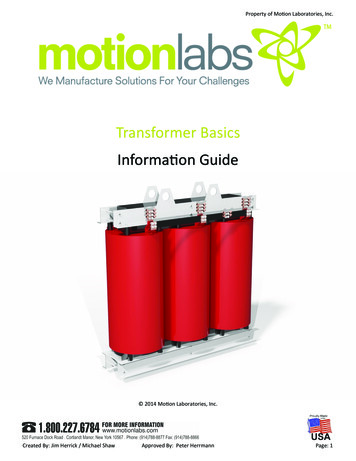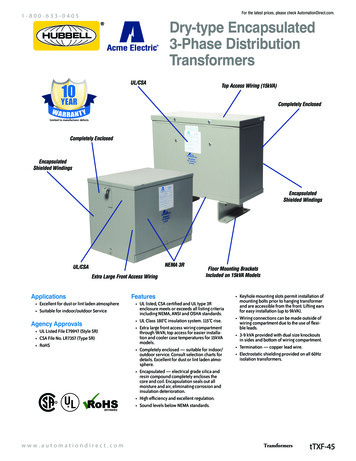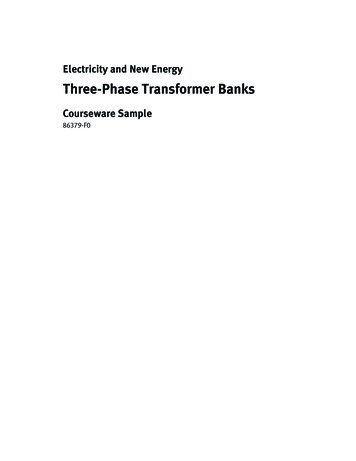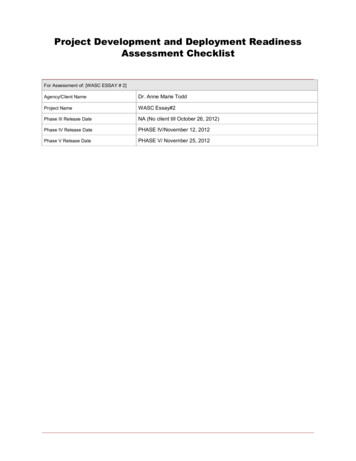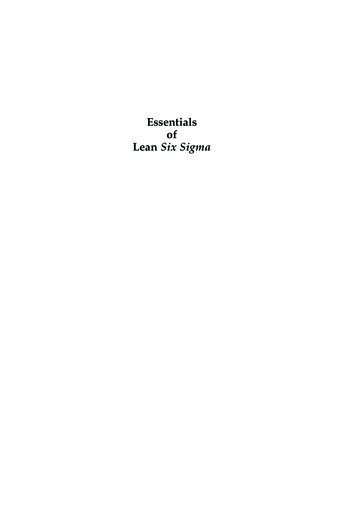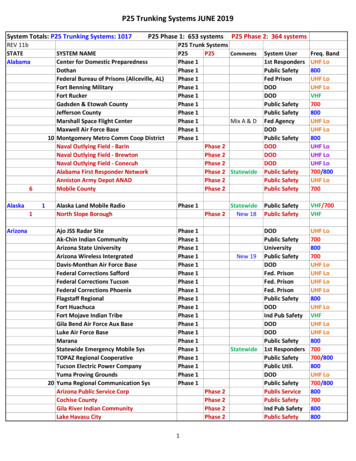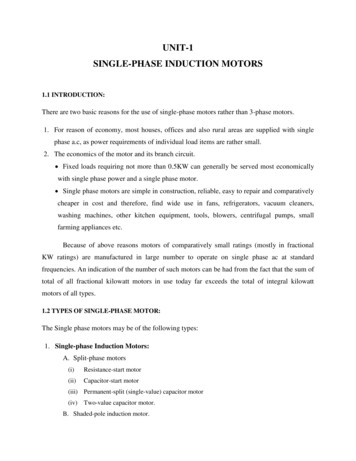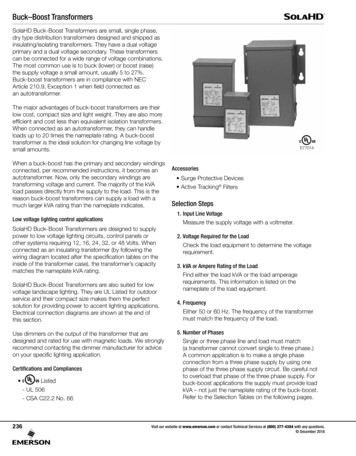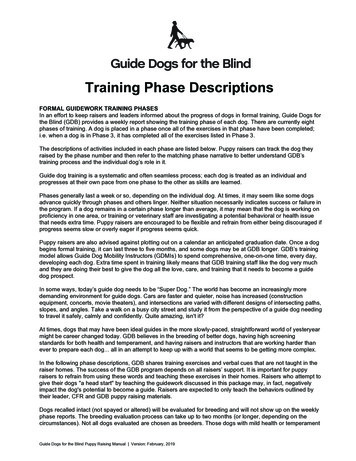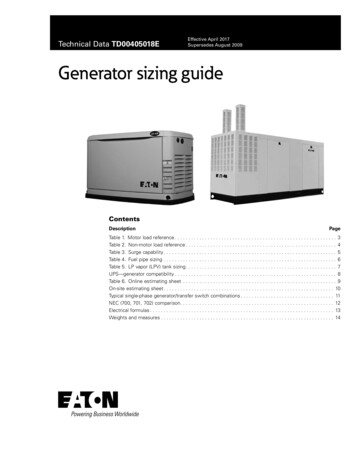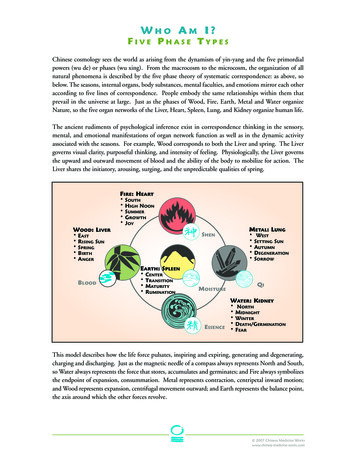
Transcription
WHO AM I?FIVE PHASE TYPESChinese cosmology sees the world as arising from the dynamism of yin-yang and the five primordialpowers (wu de) or phases (wu xing). From the macrocosm to the microcosm, the organization of allnatural phenomena is described by the five phase theory of systematic correspondence: as above, sobelow. The seasons, internal organs, body substances, mental faculties, and emotions mirror each otheraccording to five lines of correspondence. People embody the same relationships within them thatprevail in the universe at large. Just as the phases of Wood, Fire, Earth, Metal and Water organizeNature, so the five organ networks of the Liver, Heart, Spleen, Lung, and Kidney organize human life.The ancient rudiments of psychological inference exist in correspondence thinking in the sensory,mental, and emotional manifestations of organ network function as well as in the dynamic activityassociated with the seasons. For example, Wood corresponds to both the Liver and spring. The Livergoverns visual clarity, purposeful thinking, and intensity of feeling. Physiologically, the Liver governsthe upward and outward movement of blood and the ability of the body to mobilize for action. TheLiver shares the initiatory, arousing, surging, and the unpredictable qualities of spring.FIRE: HEART SOUTHHIGH NOONSUMMERGROWTHJOYWOOD: LIVER METAL: LUNGSHENEASTRISING SUNSPRINGBIRTHANGER WESTSETTING SUNAUTUMNDEGENERATIONSORROWEARTH: SPLEENBLOOD CENTERTRANSITIONMATURITYRUMINATIONQIMOISTUREWATER: KIDNEYESSENCE NORTHMIDNIGHTWINTERDEATH/GERMINATIONFEARThis model describes how the life force pulsates, inspiring and expiring, generating and degenerating,charging and discharging. Just as the magnetic needle of a compass always represents North and South,so Water always represents the force that stores, accumulates and germinates; and Fire always symbolizesthe endpoint of expansion, consummation. Metal represents contraction, centripetal inward motion;and Wood represents expansion, centrifugal movement outward; and Earth represents the balance point,the axis around which the other forces revolve. 2007 Chinese Medicine Workswww.chinese-medicine-works.com
Five phase theory, modified and reinvented to conform to our culture, affords a particularly comprehensiveschema for self-understanding. Our expansion of five phase theory into a typology postulates that eachof us is organized by a core phase--Wood, Fire, Earth, Metal, or Water--which we know as our type. Thiscore phase characterizes each of us and is the source of our deepest impulses. It functions like the hubof our wheel, while the others serve as the spokes. One phase fashions the context within which weevolve and acts as our primary frame of reference, guiding our instincts and how we live them. In short,it organizes us, body and mind.F ROM C OSMOLOGYTOT YPOLOGYOur typology derives from yin-yang and five By learning to recognize our organizing force--howphase theories. This provides a framework our soma and psyche are expressed—our nature isfor linking the disparate components of revealed. When we know ourselves, we can behavebiology, temperament, emotion, character, accordingly. The language of five phase theoryand symptoms into one unified picture. shines a light upon existential issues of identity (WhoRather than relying solely upon a am I--how am I put together?), of purpose (Whatpathological premise of inherited or acquired am I here to do?), and of destiny (who will Ipredispositions to dysfunction and disease,become, and how can I make the best of it?)we subscribe to an ontological premise thatthere is an intrinsic formative power called lithat engenders personal identity. This li, or the inborn pattern of a person’s true nature, is embodied inthe five viscera (wu zang) of the Liver, Heart, Spleen, Lung, and Kidney. The concept of li suggests thatthe primary intent or mission of a human being is teleological: to shape itself and its environment insuch a way that its life is both an expression of its imagination and intelligence (shen) and an engine foractualizing its purposes and destiny (ming).Constitutional typing classifies people according to an established set of criteria, incorporating andsynthesizing knowledge about such categories as the composition, structure, formation, and organizationof human mental and physiologic processes. Formulations of human typologies have been a part ofmany medical systems, including Ayurvedic, Unani, Hippocratic, Galenic, Homeopathic as well asJapanese, Korean and Chinese variants of Chinese traditional medicine. Modern Western typologiesinclude Jung’s psychologically based archetypes and Kretchmer’s somatic types.K NOWING YOUR T YPEOur typology suggests that there are five distinct constitutional patterns that represent five basic stylesof being in the world. To know our type is to gain insight into the goals we set, the risks we take, thecompetence we manifest, the postures we adopt toward people and projects, the expectations we hold,the things that most threaten us, and the satisfactions from which we derive the greatest rewards. To learn aboutour patterns and identify our type is to increase our capacity to forestall ailments, upsets and quandaries.Each type has physical, mental, emotional predispositions. For example, the Wood type does well underthe intense competitive pressure that upsets the Earth type and paralyzes the Water type. Water typesprefer to have time to think things through, and the Earth type feels most comfortable when people arecheerfully working together. So the Wood type thrives on the challenge and fast pace that threatens heWater and Earth types. The Metal type appreciates the same order that can hastily be cast aside by theimpulsiveness of the Wood type and the excitability of the Fire type. Earth types can be hurt anddiscouraged in attempts to be warm and friendly with Metal and Water types who remain detached andwithdrawn. Yet Earth types may also be just the animated, imposing social force these types need to beincluded in events that would otherwise pass them by. 2007 Chinese Medicine Workswww.chinese-medicine-works.com
Just as bamboo bends readily in a stiffbreeze, so the Wood type is vulnerableto the gusts of change and suddenrage. The Wood type is fiercelyindependent and exerts leadershipeasily but is at risk of being bossy andhaving a difficult time being a teamplayer. Fire easily flares, so the Firetype is prone to becoming overlyexcited and prone to high anxiety.Earth becomes easily oversaturated,so the Earth type is subject to inertia,edema and mental quagmires. Metalcuts away and restricts, so the Metaltype can excel at pruning theunnecessary but may become stiff andinsensitive. Water freezes and hardens,so the Water type is dogged and patient, but prey to sclerosis and isolation.The ancient medical sages were not merely attempting tocommunicate a set of intangible ideas, but to induce in thereader an apprehension of the nature of reality throughimages that evoked actual bodily experiences. Everydescription of natural phenomena establishes a somaticlink with internal processes, and every description ofinternal phenomena establishes a link with externalprocesses in which the procession of the five seasons (wushi) and the movement of the five viscera (wu zang) areviewed as mutually interacting and intermediating via theagency of the five phases (wu xing) or powers (wu de).Accordingly, it is axiomatic that what is observed andexperienced outwardly is mirrored inwardly, and viceversa.We chose to develop a formative typology that is basedon ontological and teleological principles as well aspathological patterns. The purposes of a successfultypology are twofold. First, it should have prognosticpower: assisting us in our capacity to make generalstatements about groups and individuals that arepredictive of both functional and adaptive trends as wellas dysfunctional and maladaptive ones. Second, it shouldenable us to describe groups of individuals and to somedegree explain the nature of their formative process.Each type thrives under certainconditions. Whereas raw juicy fruitsand salads cool and moisturize Wood,Metal, and Fire; drier, cooked foodsare better for Earth and Water. Metalcan barely tolerate the flamboyantintensity of Fire, and Fire feelsinhibited by the controlled cool calmof Metal. Wood does well under the pressure that Earth shuns, yet Wood does not have the patience ofEarth. Water has great tenacity, but less of Wood's ambition or Fire's spark. Everyone marches to oneof these five drummers. Understanding these types reveals how people handle relationships, theirsymptoms and remedies, what foods best suit them, and areas of aptitude and weakness.O UR V IRTUES C AN B ECOME O UR F RAILTIESOur strengths, exaggerated, can morph into our weaknesses, and our virtues can become our frailties.We gravitate toward an environment that suits our character; similarly, it's easiest to develop in areaswhere we have natural talent. Maslow's phrase, "When the only tool you have is a hammer, you treateverything as if it were a nail" describes typical fixations of character. For Wood it is easy to interpretany circumstance as requiring audacious action. Fire might perceive gratification as the end-goal of anysituation. Metal adheres to rules andprotocols even when these havePathology and ontology are both expressions of ourbecome a hindrance. Water mayintrinsic self-organizing process--one undermining,prefer to cogitate, perhaps losing thefragmenting, overwhelming, devolving, and the otheropportunity to realize or fulfill thoseaffirming, integrating, enlivening, and evolving. That isvisions. And Earth may be sowhy the five phase system can be used to simultaneouslyconcerned with establishing balanceto examine not only the pathogenesis of sickness but alsoand harmony that the dynamicthe ontogenesis of health.tension essential for movement andchange is neutralized. 2007 Chinese Medicine Workswww.chinese-medicine-works.com
Life depends upon the balance of theforces within us. In our culture wesometimes value one way of being morethan another. It is more acceptable to bethin than fleshy; being charming andsocial is more valued than being shy andreflective; being shamelessly selfpromoting is generally more rewardedthan being selflessly generous. Learningabout the five types is a tool foracquiring an appreciation of ourdifferences.D ILEMMASOF AT YPOLOGYThe Five Phases are not "things" but rather descriptions ofprimal forces within a universe of larger and smaller,contracting and expanding, interacting and co-generatingsystems. This relational continuum is bounded at oneend by more dense and tangible forms (Yin), and at theother by less tangible, more amorphous and diffuseforms (Yang). These five forces trace process--fromits inception through the phases: consolidation andpotentiation belongs to Water, expansion and initiationto Wood, completion and fulfillment to Fire, contractionand release to Metal, and stability and poise to Earth.The cosmos, as does each human being and process,embodies all the phases. Every individual swirls like aplanet, enveloping a hidden core (Water) and displayinga surface terrain (Fire), represented in the body by themagnetic poles of Kidney (Yin) and Heart (Yang).Rotational movement occurs within the context ofopposition between the centripetal forces of Metal andLung (contractive) and the centrifugal forces of Woodand Liver (expansive). The axis of revolution and thecenter of gravity and mass is represented by Earth, theSpleen, holding all other forces in harmonic tension.This is the dilemma of any typology: tomake true generalizations about thevarious expressions of human naturewithout ignoring the individualdifferences that are essential inunderstanding each person's uniquecharacter. No typology will be able toexplain all of the idiosyncrasies of aparticular person: its truths are broadand relative, not specific and absolute.We come back to the statement ofgeneral semantics that the map is not the territory, rather a device to get us to the neighborhood thatwe wish to explore. So, within the loose categories of our five phase system of Wood, Fire, Earth, Metal,and Water types, with complex patterns of exaggeration and collapse, we are able to make some usefulstatements about people which are both explanatory and predictive about the general nature of theirformative process in health and disease and what kinds of predicaments they are likely to encounter inthe future. This is not a method of divination--it is much more like a roadmap that indicates cities,towns, and intersections along your route of travel, or like an almanac that indicates probable seasonalweather conditions, flora and fauna that you may encounter along the way.E XAGGERATIONANDC OLLAPSE : K EANDS HENGEach of the phases can subjugate or inhibit parts of ourselves that are less developed. Our core phasecan be a bully, injuring other phases by its domination. Or it can become weak, neglecting to providethe leadership we rely upon for direction and guidance, and in turn be encroached upon by the phasethat controls it.The phases that restrain or are restrained by our core phase are the ones likely to manifest the grossdistortions of our structure and character. Oftentimes our most obvious and dramatic symptoms arelocated in the two phases along the restraining, control or ke sequence.Signs of conflict are likely to appear along the ke sequence in exaggerated patterns; and signs of weaknesswithin the predominant organ network and along the sheng sequence in collapsed patterns. Anexaggerated organ network overwhelms and oppresses others. In collapse, its force becomes dissipated,creating an unstable void. When the predominant organ network is exaggerated it needs to be subdued; 2007 Chinese Medicine Workswww.chinese-medicine-works.com
when collapsed it needs to be nourished. Exaggerated and collapsed patterns can and often do coexist,as do excess and deficiency, heat and cold. Harmony is restored when appropriate measures restorestability by easing conflict and correcting inequities.FIRE: HEART Sheng ShWOOD: LIVERKeeKng SheWhen a strident and assertive Wood typeneeds restoration, he retreats from projectsand commitments, preferring to spend hoursin solitary reading, studying, and going tothe movies like a reclusive Water type.When at his peak, he burns hot like aflamboyant Fire type, open, charismatic,demonstrative, and exciting, a magicalcommunicator. This illustrates that whenthe organizing phase (Wood) is in collapse, itgravitates toward its parent (Water), and, inexaggeration, it becomes like its child (Fire). ShengWATER: KIDNEY KeSheng Ke EARTH: SPLEEN Ke genMETAL: LUNGKe represents dynamic tension, while shengrepresents capacity. The sheng triad generates ourresources, our creative potential and our adaptivereserves. Without tension, potential has no spring,no motivating impulse, no egress; and withoutresources, motivation has no foundation, no source,no utility. Equilibrium is the outcome of poisebetween opposing forces. When the organizingpattern we call our type is harmonic, there is asatisfying complementarity between the nurturanceof our potential and the intensity that brings it forth.K E T RIADSUsually the first problems that people complain about are a result of ke sequence conflicts, an escalationof tension between the primary phase, the one it controls, and the one that controls it. This is how theexaggerated pattern develops. When the equilibrating mechanism of the organism has beenoverwhelmed by exaggeration, collapse ensues and problems along the sheng sequence become moreapparent.For example, for an Earth type, disturbances are likely to show up in Water (restrained by Earth) andin Wood (which restrains Earth). Exaggerated Earth oppresses Water and antagonizes Wood. When theSpleen is dominant, Dampness and the stagnation that occurs with it, inhibit the function of the Kidneyand Liver. 2007 Chinese Medicine Workswww.chinese-medicine-works.com
An Earth type might experience a sore low back, swollen ankles, and premenstrual water retention, allindications of Kidney disturbances, along with fullness in the head and pressure behind the eyes whichreflect Liver disturbance. When Dampness in the Spleen hampers the capacity of the Liver to makedecisions and initiate action, a person feels obsessed with small changes and decisions, reluctant tocommit to big decisions and their consequences.The effect on the Kidney is to create an unsettlingfeeling of doubt and insecurity, as if one's sourceor identity is never firmly grasped. Thus, thecharacteristic affability and gregariousness of theEarth type may be hemmed in by an undercurrentof irritability and vulnerability.This illustration emphasizes that when determiningsomeone’s type, it is central to evaluate theinteractions and relationships of the phases withinyou. For example, if you suspect that you are aMetal type, your pattern of affinities, aversions,symptoms, and emotional styles should reflectstronger tensions with Wood and Fire than withEarth and Water.T YPE D IFFERENTIATION : I T ’ S NOTW HAT YOU D O, B UT H OW AND W HYYOU D O I TIn reflecting upon your type, it's not what you dothat matters, but how and why you do it. Evie,Ed, and Susanne, all spend a great deal of timecooking. Evie manages a restaurant, Ed teachescooking classes, and Susanne frequently feeds herlarge extended family.Evie describes her attraction to this work, "I thriveon the challenge of getting my staff to function ata hum--everything planned just right so that theenergy and the product are in a flow. I enjoy theconstant demand for problem-solving--when itgets too easy, I get bored."When Ed is asked what he likes about food, heoffers a frugal, droll reply, "I like eating it." Thenhe continues to say that what concerns him is theform, "People seem to think I cut vegetables ininteresting ways. I like to take ingredients andcombine them in just the right way. I don't really care whether anybody else likes it or not. It'simportant to me to have room to move around and a clean and orderly space in which to work."Susanne, on the other hand, cooks specifically to please her diners, "What I love is looking down a long tablefull of people I care about and having them feel good about eating food I've prepared specially for them." 2007 Chinese Medicine Workswww.chinese-medicine-works.com
Evie is a Wood type, Ed is Metal, and Susanne is Earth. Evie is also a perfectionist (a Metal characteristic)and often feeds her friends (Earth), Ed takes pleasure in getting things done (Wood), and Susanne worksas a graphic designer, spending most of her time doing solitary, creative work (Water). They eachembody traits of all the phases but are most motivated and characterized by one.W E C HANGE -- O UR T YPE R EMAINS C ONSTANTWhen deciding which clothes to wear, there are usually many garments to choose from, but you selectone outfit based on how it fits and whether it truly suits you. Similarly, you have to try on different typesto see how they fit.But unlike clothing, you can no more change your type than you can your parents.Your organizing force—your li—like your blood type, is with you for life. You canalter your hair color and your weight but not your height or chromosomes. You canraise your hemoglobin but it is to no avail to wish your blood were AB-positive whenyou were born O-negative.The rocks in the river can shift, redirecting the water's course, altering the shape ofthe riverbanks, but inexorably the river, twisting and turning, follows the gravitationalpull from the mountains to the sea. In that sense, our identity, like the river, does notchange its fundamental direction of flow. How we live out our lives may shift andvary, but the primacy of one phase as our core organizing force remains; we changebut our type does not.When our motion is disturbed by external forces or internal upheaval, our pathbecomes crooked and our movement wobbly. Allied with our organizing force, wecan navigate smoothly along our path, our inner gyroscope unperturbed. Spinningfreely, we feel aligned, at home in our body and right with the world. This comfortablesense of fit and freedom is what we recognize as health.A RCHETYPESThe archetypes of the Pioneer, Wizard, Peacemaker, Alchemist, and Philosopherreflect five styles of thinking, feeling, behaving, or falling sick. While we borrow themythological concept of archetypes from Jungian psychology, we employ them as away of dressing the body of Chinese ideas in clothing that is familiar to Westernersand as a family of metaphors that evoke powerful and vivid images of general yetdistinct attitudes, patterns of behavior, and life orientations.Carl Jung identified archetypes to describe recurring themes of universal significance,synthesizing the insights of psychoanalyticthought and Eastern mysticism. Followinghis example, we've named five archetypes to represent the anthropomorphic qualities of each Phase,joining the insights of Western psychology with Chinese correspondence thinking. One Phasepredominates, shaping and defining us as well as creating the most meaningful context for our evolutionto unfold. The existential issues and questions central to our life are embodied in the symbolic archetypalfigures associated with each Phase. 2007 Chinese Medicine Workswww.chinese-medicine-works.com
Five archetypes describe the virtues and potentialities of eachPhase. Wood is personified by the Pioneer. A Wood type strikes outinto the wilderness with a bold, adventurous spirit to break newground, face challenges, overcome obstacles, and conquer theunknown. Fire is represented by the Wizard—magnetic andexciting, inspiring faith that dreams can be realized and desiresfulfilled. Earth is embodied by the Peacemaker. An Earth type isstable, centered, and relaxed, drawn toward mediation to maintainor restore harmony and unity. Metal is exemplified by the Alchemistwho observes, studies, and analyzes phenomena to extractfundamental laws and principles in the service of a universal order.Water is characterized by the Philosopher. A Water type lives in theinterior, preoccupied with seeking truth and exploring hiddenmysteries through the medium of imagination.C HARACTERIZED BYW ITHIN U SONETHE ARCHETYPESThe Pioneer pushes to beon the move—her powersprings from the muscleswhich execute action.The Wizard evokes passionand excitement—his powertingles across the surface wheresensation is experienced.The Peacemeaker sustainscontact—her power spreadsfrom the belly wherenourishment is taken.P HASE , Y ET A LL F IVE E XISTAlthough one Phase predominates as our organizing force, we existThe Alchemist makes perfectas a complex amalgam of all the Phases in continuous interplay--soorder—his power setsall Five Phases exist within every person. Like our DNA, the patternthe boundaries of breathof these relationships is the dao of our individualized process, theand pulsation.template that molds our internal and external behavior. Whenaction is demanded, our Wood kicks into gear. When it is time toThe Philosopher gives birthtake pleasure in the achievement of our goals, the Fire aspect takesto new ideas—her powercharge. When we let go of old habits and values to prepare for apercolatesin the deep innernew phase of our life, the power of Metal enables us to sigh deeplychasm of the mind.and release. When our labors demand that we stop, rest, take stockof what we have done, and rededicate ourselves to a fresh purpose,our Water aspect gives us the renewed vitality and will to carry on. When the vicissitudes of our livesthreaten to overturn or deflect us from our path, our Earth aspect returns us to an even keel.FIREWOODWAT E RE A RT HM E TA LFIVE PHASES WITHINEACH PHASE 2007 Chinese Medicine Workswww.chinese-medicine-works.com
W OOD A R C H ET YP E : T HE P I O N E E RThe Wood archetype is the Pioneer who, driven by the adventure of penetrating the unknownwilderness, is adaptive, cunning, and fiercely independent. She strikes out on her own, infatuated withwhat is new, curious about what is untried, eager to innovate, reform, and revolutionize. Action compelsthe Pioneer who vanquishes resistance with great determination.KEYS TO WOOD seeks challenge and pushes to the limitenjoys and does well under pressureloves action, movement, and adventurelikes to be first, best, and onlyTYPICAL PROBLEMS intolerance and impatience volatile emotions vascular headaches, muscle spasms,high blood pressure, nerve inflammations, migratory pain abuse of stimulants and sedativesA FRIENDLY REMINDERThe power of Woodcomes from the capacityto rapidly expand andbuild up pressure.Wood types need tomodulate their intensityand stay flexible, to beable to retreat and yieldas well as surge forwardand be undaunted.F I RE A R C H ET YP E : T HE W I Z A R DThe Fire archetype is the Wizard who imbues the mundane with the extraordinary, merging humanaspirations with divine purpose. The Wizard manifests miracles by welding divergent elements into one,generating the heat of excitement so that the reaction of fusion occurs. With catalytic energy, he bringsthe transforming power of light, love, and awareness into the world. Enchanting and persuasive, theWizard uses personal magnetism and the gift of expression to assemble groups of individuals into onebody, gathering us up into a shared expanse of vision and feeling.A FRIENDLY REMINDERKEYS TO FIRE relishes excitement and delights in intimacykeenly intuitive and passionately empatheticbelieves in the power of charisma and desireloves sensation, drama, and sentimentTYPICAL PROBLEMS anxiety, agitation, and frenzybizarre perceptions and sensationsnervous exhaustion and insomniapalpitations, sweating, hypoglycemia, rashes, palsyThe power of Firecomes from the capacity toliberate heat and light andrealize joy and fulfillment.Fire types need to tempertheir chemistry and containtheir fervor, conserving aswell as sharing their resources,withdrawing and separatingas well as embracing andmerging. 2007 Chinese Medicine Workswww.chinese-medicine-works.com
E ARTH A R C HET YP E : T H E P E A CE M A K E RThe Earth archetype is the Peacemaker who, through her power to establish and sustain relationships,nurtures and promotes our connectedness to each other and our world. The Peacemaker values serenityand stability, mediating conflict through her gift of focusing on what is mutually shared, convertingdiscord into harmony. Chameleon–like, she can assume and enhance the attributes of those around her,putting people at ease in an environment of trust. The Peacemaker embodies sympathy and caring, aready advocate for those in greatest need—of friendship,sustenance, and recognition.A FRIENDLY REMINDERKEYS TO EARTH wants to be involved and neededwants to be all things to all peopleseeks harmony and togethernessinsists upon loyalty, security, and predictabilityTYPICAL PROBLEMS The power of Earth comesfrom the capacity to link,nurture, and sustain. Earthtypes need to balance theirdevotion to relationship withsolitude and self–expression,developing self–reliance aswell as buildingcommunity.worry, obsession, and self–doubtmeddling and overprotectiveover–extended and inertlethargy, indigestion, unruly appetites, water retention, muscle tendernessM E TAL A R C H ET YP E : T HE A L CH E M I STThe Metal archetype is the Alchemist, who seeks the perfection of form and function. Through hispower of discernment, he distills what is good and pure from what is coarse and primitive. In his strivingto extract order from chaos, he molds situations so that people perform their tasks with elegant precision.Defining and refining, the Alchemist is the keeper of standards and measures, the source of aesthetic andmoral values, the defender of virtue, principle, and beauty.KEYS TO METAL likes definition, structure, and disciplinerespects virtue, discretion, and authorityseeks to live according to reason and principlereveres beauty, ceremony, and refinementTYPICAL PROBLEMS indifferent, formal, distant, and inhibited autocratic, strict, and persnickety stiff joints and muscles, dry skin and hair, shallow breathing,sensitive to climate, poor circulation self–righteousness and disillusionmentA FRIENDLY REMINDERThe power of Metal comesfrom the capacity to shapeand define. Metal typesneed to compensate for theirrationalty, self– control, andmeticulousness with passion,spontaneity, and socialinvolvement. 2007 Chinese Medicine Workswww.chinese-medicine-works.com
W ATE R A R C HET YP E : T H E P H I L O SO PH E RThe Water archetype is the Philosopher who brings to light that which is hidden, uncovering newknowledge, dispelling mystery, eroding ignorance. Like an old–time prospector, she sifts through thegravel of notions and beliefs, tireless in her effort to apprehend the nature of reality. Time is the pickand shovel of the Philosopher who exhumes the bones of culture that endure, doggedly in search oftruth. Able to envision what can be, she is critical of what is. As the custodian of our ancestral memoriesand dreams, she articulates our aspirations.A FRIENDLY REMINDERKEYS TO WATER articulate, clever, self–sufficient, and introspectivepenetrating, critical, and scrutinizingseeks knowledge and understandinglikes to remain hidden, enigmatic and anonymousTYPICAL PROBLEMS emotionally inaccessible and undemonstrativeisolation and lonelinesstactless, unforgiving, and suspicioushardening of the arteries, deterioration of teeth and gums,back ache, chilliness, loss of libidoThe power of Water comesfrom the capacity toconceive, concentrate,and conserve.Water types need tooffset their toughness,bluntness, anddetachment withtenderness, sensitivity,and openness, riskingsoftness and contact,exposure andattachment. 2007 Chinese Medicine Workswww.chinese-medicine-works.com
according to five lines of correspondence. People embody the same relationships within them that prevail in the universe at large. Just as the phases of Wood, Fire, Earth, Metal and Water organize Nature, so the five organ networks of the Li
